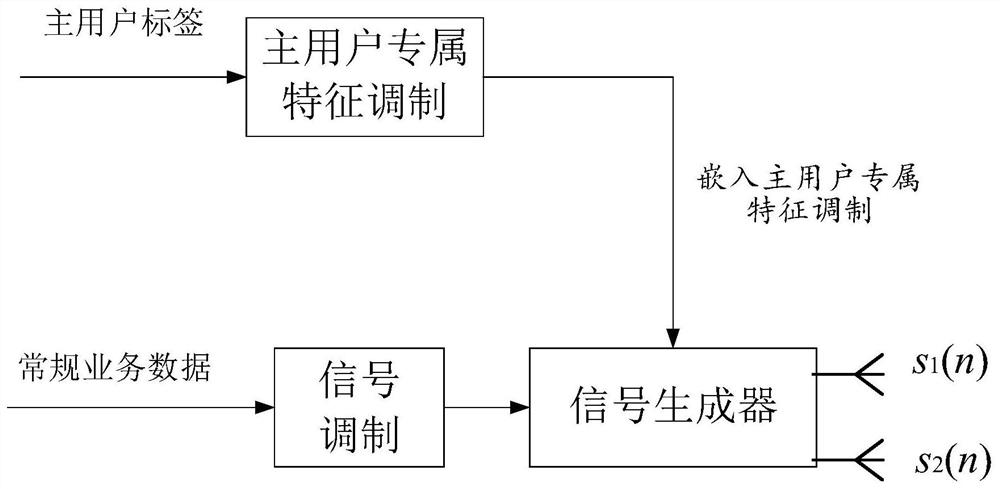Adaptive Spectrum Sensing Method, System, Medium and Terminal Based on Pre-Evaluation Processing
A spectrum sensing and self-adaptive technology, applied in the transmission system, transmission monitoring, electrical components, etc., can solve the problems of rough sensing process, large spectrum sensing uncertainty, no pre-evaluation processing, etc., to achieve easy promotion and application, Ease of technology, effect of improved precision
- Summary
- Abstract
- Description
- Claims
- Application Information
AI Technical Summary
Problems solved by technology
Method used
Image
Examples
Embodiment 1
[0095] Embodiment 1. Feature detection, multi-antenna quantity judgment
[0096] Step 1. It is set that the receiving end of the cognitive user has a total of one receiving antenna, and each antenna independently executes its own decision process. First, according to the given sensing cycle length of the system, each antenna collects signals within the range of the cycle length. where the received signal on the i-th antenna (i∈[1,I]) can be expressed as r i (n)=h i s(n)+v i (n), n∈[0,nn-1] represents each sampling point, and nn represents the total number of sampling points, which is related to the given perception period length of the system. h i =[h i1 ,h i2 ] is the channel state between the two transmitting antennas of the primary user and the ith receiving antenna of the cognitive user, s(n)=[s 1 (n),s 2 (n)] T , v i (n) represents the additive white Gaussian noise on the i-th antenna.
[0097] Step 2. The r of each receiving antenna i (n) After the collection...
Embodiment 2
[0103] Embodiment 2, feature detection, multi-antenna feature combination judgment
[0104] Step 1. The receiving end of the cognitive user has a total of I receiving antennas, and each antenna performs its own decision process independently. First, according to the given sensing cycle length of the system, each antenna collects signals within the range of the cycle length. where the received signal on the i-th antenna (i∈[1,I]) can be expressed as r i (n)=h i s(n)+v i (n), n∈[0,nn-1] represents each sampling point, and nn represents the total number of sampling points, which is related to the given perception period length of the system. h i =[h i1 ,h i2 ] is the channel state between the two transmitting antennas of the primary user and the ith receiving antenna of the cognitive user, s(n)=[s 1 (n),s 2 (n)] T , v i (n) represents the additive white Gaussian noise on the i-th antenna.
[0105] Step 2. The r of each receiving antenna i (n) After the collection is c...
Embodiment 3
[0111] Embodiment 3, energy detection, multi-antenna number judgment
[0112] Step 1. The receiving end of the cognitive user has a total of I receiving antennas, and each antenna performs its own decision process independently. First, according to the given sensing cycle length of the system, each antenna collects signals within the range of the cycle length. where the received signal on the i-th antenna (i∈[1,I]) can be expressed as r i (n)=h i s(n)+v i (n), n∈[0,nn-1] represents each sampling point, and nn represents the total number of sampling points, which is related to the given perception period length of the system. h i =[h i1 ,h i2 ] is the channel state between the two transmitting antennas of the primary user and the ith receiving antenna of the cognitive user, s(n)=[s 1 (n),s 2 (n)] T , v i (n) represents the additive white Gaussian noise on the i-th antenna.
[0113] Step 2. The r of each receiving antenna i (n) After the collection is completed, its ...
PUM
 Login to View More
Login to View More Abstract
Description
Claims
Application Information
 Login to View More
Login to View More - R&D
- Intellectual Property
- Life Sciences
- Materials
- Tech Scout
- Unparalleled Data Quality
- Higher Quality Content
- 60% Fewer Hallucinations
Browse by: Latest US Patents, China's latest patents, Technical Efficacy Thesaurus, Application Domain, Technology Topic, Popular Technical Reports.
© 2025 PatSnap. All rights reserved.Legal|Privacy policy|Modern Slavery Act Transparency Statement|Sitemap|About US| Contact US: help@patsnap.com



